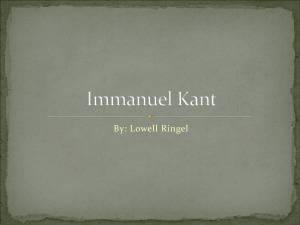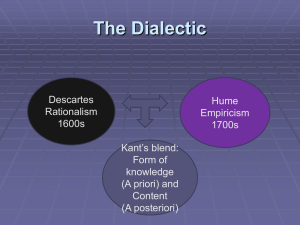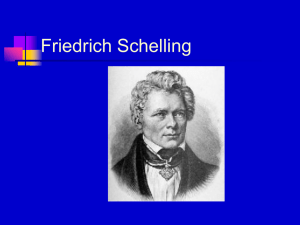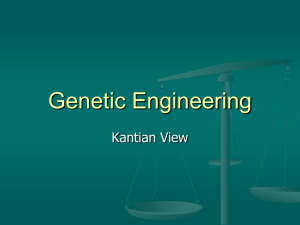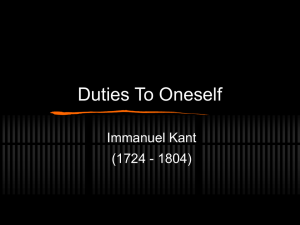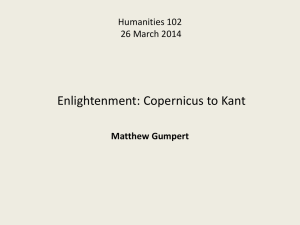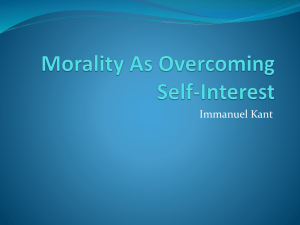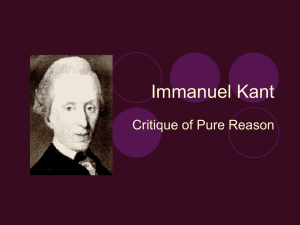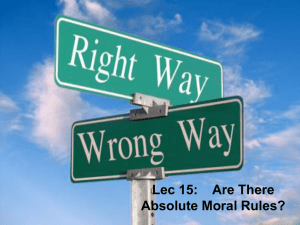Kant`s Theory of Mathematics
advertisement
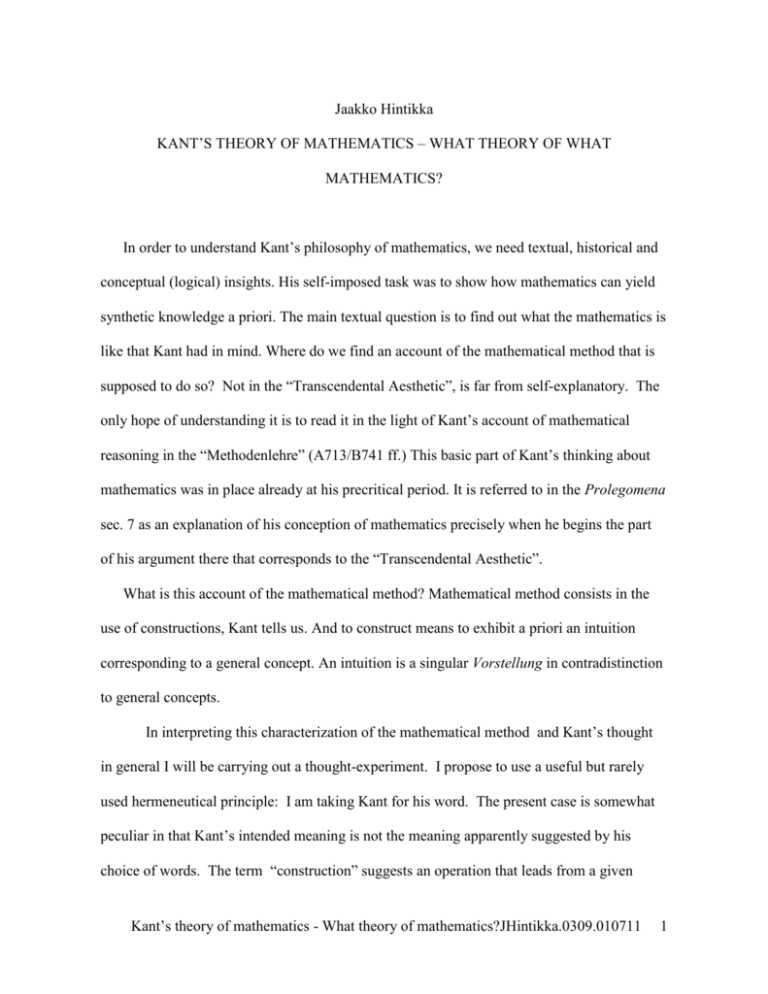
Jaakko Hintikka KANT’S THEORY OF MATHEMATICS – WHAT THEORY OF WHAT MATHEMATICS? In order to understand Kant’s philosophy of mathematics, we need textual, historical and conceptual (logical) insights. His self-imposed task was to show how mathematics can yield synthetic knowledge a priori. The main textual question is to find out what the mathematics is like that Kant had in mind. Where do we find an account of the mathematical method that is supposed to do so? Not in the “Transcendental Aesthetic”, is far from self-explanatory. The only hope of understanding it is to read it in the light of Kant’s account of mathematical reasoning in the “Methodenlehre” (A713/B741 ff.) This basic part of Kant’s thinking about mathematics was in place already at his precritical period. It is referred to in the Prolegomena sec. 7 as an explanation of his conception of mathematics precisely when he begins the part of his argument there that corresponds to the “Transcendental Aesthetic”. What is this account of the mathematical method? Mathematical method consists in the use of constructions, Kant tells us. And to construct means to exhibit a priori an intuition corresponding to a general concept. An intuition is a singular Vorstellung in contradistinction to general concepts. In interpreting this characterization of the mathematical method and Kant’s thought in general I will be carrying out a thought-experiment. I propose to use a useful but rarely used hermeneutical principle: I am taking Kant for his word. The present case is somewhat peculiar in that Kant’s intended meaning is not the meaning apparently suggested by his choice of words. The term “construction” suggests an operation that leads from a given Kant’s theory of mathematics - What theory of mathematics?JHintikka.0309.010711 1 geometrical configuration to another. The term “intuition” suggests that this operation takes place in a perceptual or mental space. Yet Kant’s own definitory explanation of these terms is much more general and abstract than these suggestions. To construct is for him nothing more and nothing less than to introduce a singular representative of a general concept. Intuition is that singular representation. But his leads us to an unfamiliar direction. In order to take Kant seriously we have to look away from the normal connotations of the words “construction” and “intuition” and interpret him to rely only on his definitory meaning of the method of mathematics. Hence, all that there is by definition to this method is the introduction of singular representatives for general concepts. What if we take Kant to mean what he says in this apparently highly abstract notion of the mathematical method? I do not think that any practicing mathematician to-day will at first recognize the conceptual tools of his trade in these definitions. What on earth can Kant have in mind? A simple and powerful answer is in fact available. Any logician worth her or his truth value who is willing to look away for a moment from Kant’s terminology and historical context will have a déjà vu experience here. What she will realize is that Kant is not talking about specifically mathematical reasoning in our present-day sense. He is talking about the kind of reasoning codified in what we call first-order logic (quantification theory). Kant is talking about the rules of instantiation that are the backbone of our contemporary first-order logic, that is, the rules of existential and universal instantiation. All that there is to Kant’s notion of representing a concept in intuition is by his own definition logical instantiation and nothing more. This answer may at first seem far-fetched and arbitrary, when systematically considered, as well as totally anachronistic, when historically considered. It seems to 2 presuppose that Kant is using the terms “intuition” and “construction” in a totally foreign sense. Most philosophers have therefore refused to take Kant at his word. Kant did not know any of our contemporary logic, and in so many words contrasted to each other mathematical and logical reasoning. Hence it might at first seem absurd to equate his idea of the mathematical method with certain modes of reasoning in modern logic. This objection is a mere perspectival illusion, however. On the one hand, Kant’s notion of logic was extraordinarily narrow, comprised essentially only of syllogistic reasoning. On the other hand, he was perfectly familiar with a plethora of first-order logical inferences, including plenty of applications of reasoning by instantiation in mathematics. However, they were not listed at his time under the title of “logic”. They were the inferences one finds in traditional axiomatically developed elementary geometry, especially the way in which propositions were presented by Euclid and many other traditional mathematicians. They were the writers who had given Kant his idea of mathematical reasoning. Euclid’s format was at Kant’s time followed in schoolbooks of geometry, and it obviously dominated Kant's thinking about mathematics. In this historical perspective, it is not at all surprising that Kant should have thought rules of instantiation as being characteristically mathematical modes of reasoning, even though they are as general and as formal as the rules of Aristotelian logic. They were used all over the place in traditional elementary geometry. Hence, it is instructive to have a closer look at how Euclid presented a geometrical theorem. He first announces a general proposition. (“In every triangle the sum of their angles equals two right angles.” ) But he never, never does anything on the basis of this general announcement or protasis. Nor could he really do anything by means of Aristotelian logic. The history of the philosophy of mathematics is dotted by attempts to turn Euclid into a 3 syllogistic form. Only the most obstinate syllogistizers had the tenacity to push their hopeless attempt beyond the first couple of theorems. And it is obvious why these attempts failed. Geometrical reasoning is quantificational and relational, but Aristotelian logic suffices only for monadic reasoning. It cannot cope with dependent quantifiers. Nor did Euclid (or Kant) have available to them any other technique called logic for the purpose. Hence they had to reduce somehow their reasoning with dependent quantifiers to reasoning with single quantifiers by means of instantiation rules. In a way the same reduction is implemented in ordinary first-order logic. But how? By means of instantiation rules This is precisely what Euclid did. He begins his exposition of a theorem typically with a general announcement of the theorem, called protasis. (“In every triangle, the sum of the three angles equals two right angles.) However, he quickly takes a step away from the protasis, in a step that is sometimes dismissed as a mere expositional device. As it used to be said, he applies his general annunciation to a special case. He says something like “I say, in the triangle ABC the sum of the three angles , and equals two right angles.” In doing so he seems to assume that a diagram of the triangle is drawn or has been drawn to illustrate the theorem. (See the figure below.) This part of a proposition was known as the ekthesis or exposition. C E A B D 4 Ekthesis is not a mere pedagogical trick or illustration. Nor is it some kind of nonlogical “diagrammatic” reasoning. If you seriously try to work out the logic of Euclid’s arguments, you will see that this step amounts to instantiation. The rest of his argumentation refers to the instantiated figure, not to the general enunciation. Indeed, Euclid could not very well prove this theorem in general terms without referring to the particular geometrical objects somehow so introduced. For otherwise he would have had to argue in terms of dependent quantifiers. For instance, intuitively speaking, he would have needed particular objects as stepping -stones for the introduction of further objects by constructions justified by postulates and earlier solutions to problems. Such additional geometrical objects are introduced in the next part of a Euclidean proposition, known as the kataskeye, sometimes called auxiliary construction. For instance, Euclid might say, “Produce side AB beyond B to D and draw a line parallel to AC through B.” The introduction of such an auxiliary object is logically speaking nothing but another instance of instantiation. As you can ascertain and as Kant emphasized (see A716/B744), without such an introduction of new geometrical objects you have typically no hope of proving the theorem. The true power of Euclid’s procedure manifests itself in these auxiliary constructions, made possible by the ekthesis. For most of Euclid’s propositions simply cannot be proved without the kataskeye. Only in the next step, called apodeixis or proof, is any overtly deductive argument carried out. There Euclid takes the amplified figure and reasons about it. He notes that equals EBD and equals CBE (both being consequences of earlier theorems). This is enough to prove that + + = 180. 5 Apodeixis obviously involves logic and nothing but logic. The very same word was in fact used by Aristotle for a proof in logical contexts. But that reasoning was typically rather elementary. Typically, it turns on the use of identities between suitable geometrical objects (as in the present example). In a passage (that admittedly is not easy to interpret) Aristotle apparently says that when the constructions have been carried out, the theorem is obvious. (See Metaphysics , 9, 1051a21ff. For the interpretation of this passage, see Heath, Mathematics in Aristotle, pp. 216-217.) In the light of this Euclidian practice, Kant’s account of the mathematical method can only seem obvious, not to say commonplace. Perhaps it seemed so obvious to Kant that he thought that he could relegate it to the end of the Critique of Pure Reason. This shows the meaning of traditional geometrical terminology in Kant’s writings. For instance, when he says that the proofs of mathematicians are analytic “as required by the nature of apodictic certainty”, his very choice of words shows that he has in mind only the apodeixis part of a Euclidean proposition, not the ekthesis or in the kataskeye. Maybe there are further clues in Kant’s usage. For instance, why does Kant call his arguments about space the “metaphysical exposition” and the “transcendental exposition” of this concept? Why concept, since his conclusion is that space is not a concept but an intuition, that is, a representation of a singular object? Well, in his “expositions” Kant moves from considering a concept to considering a particular object falling under it, just as Euclid in his ekthesis or “exposition”. Since the apodeixis is merely logical, the specifically mathematical reasoning in Kant’s sense is carried out in the ekthesis and in the kataskeye. But what happens in these parts of a proposition is instantiation, introduction of objects to exemplify certain geometrical 6 concepts which may not look like discursive reasoning. In any case, we can see that the connection between ekthesis and instantiation is not anachromistic. Aristotle was well aware of the mathematical meaning of ekthesis and possibly took it over from mathematicians’ terminology. (See here Einarson 1936.) But he uses it also in his logical theory to express what obviously amounts to instantiation. There is even an intriguing anticipation in the Aristotelian tradition of Kant’s doctrines of space as a form of outer perception. Alexander the Commentator held that the use of ekthesis is suspect in logic because according to him it was based on sense-perception. This geometrical background of Kant’s theory also explains his use of the terms “construction” and “intuition” in an apparently unfamiliar, purely logical sense. For in a geometrical context the requisite uses of instantiation were manifested precisely as the constructions carried out in ekthesis and ketaskeye. And what happens in those two steps is in the traditional jargon but an introduction by construction of certain geometrical objects so that we could consider a theorem and its proof with the help of our visual intuition. A further connection between instantiation and intuition in the commonplace sense can be established through the additional Aristotelian assumption that particular objects can be known only by perception, not by reason. I have examined earlier the role (or at least one role) of this assumption in Kant’s thought. Here I will not retrace this examination, however, largely because I am presenting a way in which Kant could have arrived at this theory of mathematics without the Aristotelian assumption. It is in any case not unnatural for Kant to call an instantiation step in mathematical reasoning intuitive. That is how we in fact make our arguments more intuitive in the commonplace sense. Kant speaks in this context of the use of points or fingers (B16), not 7 unlike Tom Lehrer who suggested that doing arithmetic in base 8 is just like doing it in base 10 if you are missing two fingers. In geometry, the figure we construct can also serve to illustrate our reasoning, and arbitrary relations can often be depicted by arrows so as to make a logical argument more “intuitive” in the commonplace meaning of the term. But by definition the intuition introduced in a construction is, according to Kant, strictly speaking nothing more and nothing less than the introduction of a particular representative of a (possibly complex) general concept, that is, an instantiation. It is thus obvious that we have to take Kant for his word and assign only the logical instantiation sense to his concepts of intuition and construction. But then we have a major conclusion in our hands. What this conclusion means from the vantage point of our contemporary philosophy and logic is something quite striking. It means that for Kant one’s faculty of intuition is not a separate source of insights in one’s mind. Intuition operates through discursive rules of reasoning which in the light of hindsight can be captured in explicit logic. At A734-B762 Kant indicates that even apodictic proofs can be intuitive, clearly in the sense that they make use of results of constructions. This makes nonsense of much of recent discussions of Kant’s theory of mathematics and of the role of intuition there. For in these discussions it is generally assumed that appeals to intuition are something different in kind from the uses of logical rules of reasoning. It means reading Kant as if he were using the terms “intuition” and “construction” as if he were using them in their loose popular sense and not in the precise one which he defines in so many words and which we have been discussing. Kant’s examples can hopefully serve to disabuse philosophers from the separation assumption in other contexts, too. Kant himself goes as far as to say that algebra turns on the use of intuitions. (A734-B762) Of course he 8 does not mean that algebra uses evocative diagrams or anything like that. What he has in mind is that algebraic letter symbols stand for particular numbers, not properties or relations of numbers. What all this shows is that Kant’s views on intuition have no bearing on our contemporary philosophers’ discussions of intuition as a separate source of mathematical insights. It might be objected here that my account applies only to geometrical reasoning and that the axioms of geometry are based on intuition in a sense that is related to sense perception and presupposes a separate faculty of intuition. Now Kant does think that to realize the truth of axioms it suffices to exhibit them by instantiation, without the need of any apodeixis to back them up. This does not change what has been said about the absence of any special faculty of intuition, however, in our geometrical knowledge. For the certainty of axioms is according to Kant not due to perception-like intuition but (as it will be shown later in this paper) to our maker’s knowledge of geometrical space. There is also a much more general moral for philosophers and even psychologists of mathematics and logic here. It is simply not true that a step of reasoning cannot be at one and the same time logical and intuitive. And this is not just a matter of terminology. What happens in the most fundamental form of logical reasoning, first-order reasoning in the tableau form, is that all logical proofs are construed as frustrated (counter) model constructions. Such constructions are in principle as anschaulïch as anything you can find in studies of diagrammatic reasoning. This point is worth emphasizing. Some thirty years ago some cognitive psychologists came up with what they thought of as an interesting new idea involving the notion of mental 9 model. This idea was that we humans make use of mental models even in our deductive reasoning. If these psychologists had been familiar with the work of Evert Beth and Jaakko Hintikka, they would not have found this a new perspective on deductive reasoning. Instead, they might have been led to ask the really interesting question, not about why and how there is a modeling element to deductive reasoning, but why and how there is anything there that is not intuitive in this model-building sense. Realizing the compatibility of logic and intuition may very well be the beginning of wisdom in the philosophy of mathematics. At the very least, it prompts intriguing further questions. For instance, was Frege’s avoidance of instantiation rules in his logic merely another aspect of his general criticism of the reliance on intuition in the foundations of arithmetic? Is this how Hilbert could reconcile his axiomatist approach to geometry with an emphasis on anschaulche Geometrie? Another insight that we can extract from Kant’s Euclidean precedents is that identifying a step of geometrical reasoning as using intuition has by itself nothing to do with the justification of that step. Strictly speaking, it only means that the step involves the introduction of a new object into the argument. It corresponds in Euclid to the use of ekthesis or kataskege. Such steps of argument are not justified by appeal to a faculty of intuition. They are justified by the assumptions Euclid calls postulates. And logically speaking in Euclid postulates are (or at least imply) existence assumptions. A transcendental justification of mathematical methods therefore have to deal with the earlier instantiation of existential instantiation in general, not with particular uses of intuition. In Kant, the ultimate transcendental justification of a step of instantiation is not any perception-like faculty of 10 intuition, but the status of geometrical objects as our own creations of which we can have “maker’s knowledge”. The same applies mutatis mutandis to axioms as distinguished from postulates. Kant thinks that they can be seen to be true simply by instantiating them. However, in prooftheoretical terms this means that ekthesis is necessary, even though no other parts of a typical Euclidean come into play. Hence, in this perspective the justification of axioms too depend on the justification of postulates. We can also see at this point the confusion of the current terminology by philosophers. They rountinely identify logical (and other conceptual truths) with analytic truths. But what are analytic truths? Presumably truths readable by analyzing something. But what? What is being analyzed in an inference from A to B? The original Leibnizen answer is in effect: the ??? of A. This answer has been adopted by subsequent philosophers. But is it Kant’s answer? For Euclid, the premises S is “exposed” by means of a figure constructed by using ekthesis. The natural thing to say about them is that a proof of the conclusion is analytic if it can be carried out entirely by analyzing this figure, that is, by an apodeixis alone, without kataskege. But that makes an “analytic” proof in geometry purely logical in Kant’s narrow sense of logic, whereas the use of instantiation rules makes proofs synthetic. Thus we can fully understand kant when he says that a logical proof (an apodeixis) is analytic while the use of the mathematical method makes typical mathematical reasoning synthetic. 11 Another corollary to these insights we have reached is that all theories of special diagrammatical reasoning are beside the point. There is no theoretical difference in kind between reasoning in terms of formal symbols and reasoning in terms of diagrams. Wittgenstein once asked whether we need intuition in logic. He answered that language provides the necessary intuitions. He probably had in mind his own picture theory of language, but his point applies independently of any special theory, as shown by the tableau and tree methods in logic. To return to Kant, what all this implies is a new take on Kant’s overall project in his philosophy of mathematics. It was to justify the power of the mathematical method to produce synthetic a priori truths. We have seen that the gist of this method was the use of instantiation rules. Hence the main aim of Kant’s entire theory of mathematics is an epistemological justification of instantiation rules. But this does not seem to make any sense. Whatever Kant’s conception of logic was or may have been, from our perspective the relevant instantiation rules are purely logical. The only justification they need lies in their status as logical rules, that is, truth-preserving rules. Indeed, the perceptive philosopher Evert Beth, who first diagnosed the eighteenthcentury controversies about ekthesis, about “general triangles” and such, as being about logical instantiation rules took his observation as a conclusive solution to this entire bunch of problems. This apparent difficulty of making sense of Kant’s transcendental problem on the basis of his “Methodenlehre” statements is undoubtedly one reason why the interpretation presented here is easily found prima facie implausible. Indeed, even the originally less obvious of the two instantiation rules, the rule of existential instantiation, admits of an apparently obvious explanation. Consider the step from 12 an existentially quantified sentence (x)F[x] by this rule to an instantiating sentence of the form F[]. This is just the same kind of step as is taken in a court of law when an unknown perpetrator or otherwise identified party to a lawsuit is referred to, not as as in my logical example, but as John Doe or Jane Roe. We are merely deciding to discuss entities of a certain kind by speaking of an arbitrarily chosen representative of theirs. At least one informed witness, John Wallis, claimed that this bit of legalese was the actual historical model of the use of letter symbols for unknowns in algebra. However, a critical thinker should not take such explanations for granted. There are in any case wider questions that should be raised here. The “dummy names” that are introduced in existential instantiation are in effect symbols for unknown entities just like the x’s and y’s in algebra. In fact, one can consider the entire first-order logic as a clumsily formulated universal algebra. In algebra we can see how the “unknowns” represented can serve a purpose. Although we do not initially know them, we can assume that they exist and then note that they can bear relations and chains of relations to each other, including relations of functional dependence. By using these dependence relations, we can relate the unknowns to known objects and known quantities and thereby “solve the equation”, that is, find out what they are. This can be thought of as a justification of instantiation rules. However, this kind of justification is not nearly as unproblematic as it seems to be. How there can indeed be a problem here as shown by Aristotle’s theory of science. For Aristotle, each science is based on a generic premise that serves to identify the objects of that science and postulates their existence. Hence there literally is no place for considering unknown entities in Aristotelian science. For him, the is of identification was built into his 13 generic sense of being, which is the deep reason for his “horror of the unknown” exemplified in many places in his philosophy. Essentially the same question is in fact the conundrum described by Kant in Prolegomena sec.7. We are obviously doing all right as long as we are dealing with a posteriori intuitions, that is, with particular representations of known objects. But an intuition a priori is supposed to represent an unknown object not given to us in experience. How can we possibly trust reasoning that uses such merely “postulated” objects. What is the justification of postulating them? Here we are beginning to see the true nature of Kant’s attempted justification of the mathematical method. He was justifying what was called the method of analysis and synthesis and what is implicitly the cornerstone of all reasoning about unknowns. But this does not bring out the full depth of Kant’s problem. In order to reach this depth, we have to pursue further the comparison with the Greeks. We have to ask: Where did Kant get his idea of this logic of instantiation? The answer has already been given: from the Greek mathematical practice. But this answer prompts a further question. What precisely was the logic of Greek mathematicians? In particular, what precisely were the instantiation rules that they used and Kant sought to justify? Here we come to a massive fact that has eluded scholars. What was the characteristic way of the reasoning used by Greek geometers? This historical question can be approached by asking the apparently trivial question: What is the most conspicuous difference between the way Greek geometers expounded their results and modern mathematicians’ practice? The obvious answer is that the Greeks often presented their discoveries as solutions to problems whereas modern mathematicians virtually exclusively present similar results as 14 existential theorems. (For the tradition of problems in ancient Greek mathematics, see Wilbur Knorr 1986.) Indeed , Zeuthen and some later historians have maintained that the problems of the Greeks are simply existential theorems in disguise. Later, more critical historians have by and large given up this view, thus leaving a lot of questions unanswered. The answer to the main question is nevertheless perfectly straightforward. What are problems? They are questions, with their solutions as answers. Now what is the logic of questions and answers? Not the plain first-order logic, but quantified epistemic logic. After all, questions are requests of information, that is, of certain items of knowledge. Thus we must conclude that the logic employed by Greek geometers is not extensional first-order logic, but typically epistemic logic. This is the massive but neglected fact referred to earlier. I would go as far as to claim that major parts of the ancient Greek mathematical literature cannot be understood without appreciating this fact. On the level of quantification logic, the main point can be expressed roughly by saying that the objects the Greeks were talking about in many contexts had to be known objects; whereas our first-order logic deals with all objects in the universe of discourse. The epistemic logic in effect penetrated also the theorems of ancient mathematicians. This is because the constructions carried out in the ekthesis and in the kataskeye parts of propositions often relied on solutions of earlier problems. What difference does the distinction between ordinary extensional reasoning and epistemic reasoning make? One can present arguments in epistemic logic in a form which is rather like the format of the usual. There are certain important differences, however. On the occasions at which Quine would say that we are “quantifying into” an epistemic context, instantiation is allowed 15 only with respect to known individuals. We have to know of the substitution-values used in instantiation what they refer to. This obviously matters, importantly for Kant’s project of justifying instantiation rules. Hence we have to examine carefully the logic that the Greeks and following them Kant had in mind. Are there indications that ancient Greek geometers were aware of the epistemic character of their reasoning? In view of what was just found, this leads to the question: Are there any indications that Greek mathematicians like Euclid paid attention to the question as to whether certain geometrical objects are known or, as they put the question, whether certain geometrical object is a “given” (didomenon)? This word cannot be taken in its literal sense, for such givenness often was not literally given for free but had to be established by an argument. What is obviously meant is a known object. (Later, Arabic mathematicians did in so many words speak of known objects instead of given ones.) All philosophers of mathematics are likely to know Euclid’s Elementa. Few have studied in real detail Euclid’s other surviving book, and fewer still have claimed to understand what it is about. The book is called Data. It has always been known to scholars, but not paid much attention to. As far as I know, the first time it appeared as a separate volume in English translation was 1993. Now a datum means something that is given. Euclid’s entire book is devoted to questions of the form: When a certain geometrical object or configuration is given, what else is given? Now we can for the first time in the history of mathematics understand why Euclid devoted such an extraordinary amount of attention to questions that have had little interest to modern mathematicians. The answer is that Euclid was concerned about the conditions of instantiation in his geometrical reasoning which was epistemic rather than plain logic. Thus 16 we can now appreciate in a new way large parts of Greek mathematical literature. We can also see how many different facets Kant’s problem of justifying instantiation rules has. We can also see more closely the relation of the Greek notion of construction to the concept of existence. Constructions were not just proofs of existence. Rather, a construction was a way of showing that an object was known. The Greek mathematicians did talk of existence also when no Euclidean construction was known to be possible. Indeed, a typical construction served to show how we can come to know a geometrical object by showing how one can construct it from known objects. Zeuthen was thus both right and wrong. Solutions of problems are not existence theorems. They are proofs of known existence. But what does this epistemic character of Kant’s logic imply for his problem of justifying instantiation rules? Justifying them becomes highly difficult. One idea in ordinary nonepistemic logic was to interpret them as using instantiation to introduce quasi-names for unknown “John Doe” individuals. But in epistemic logic, instantiation is typically allowed only with respect to known individuals. This paradox can be resolved, however, (Its paradoxiality helps to explain, though, why Kant was so deeply puzzled by the use of instantiation rules.) Kant’s problem can be illustrated and brought to a sharper focus by considering a situation where the justification of instantiation seems to be most difficult. In using the analytic method on problems, we assume that the sought-for constructions have been carried out, and then argue backwards toward known (“given”) objects and theorems. If we do not assume more, the process may seem impossible to justify. For the Greeks, instantiating construction must yield known objects. But how can one construct a known object starting from unknown objects? 17 Systematically (logically) speaking, the answer is that in using epistemic logic the analytic method itself has to be re-interpreted. The hypothetical assumption that the problem has been solved or that a theorem has been proved must be understood as postulating that all the objects requisite for the solution are known. We can in fact use in epistemic reasoning the same “analytic” backwards reasoning as in the nonepistemic case. But there are some important differences between the two cases. In epistemic logic, we not only have to assume, literally “for the sake of argument”, not only that the “unknowns” exist but also that they are already known. Furthermore, in arguing backwards to known objects, we have to infer, not only the existence of an individual from the existence of another individual, but to infer its being known from the knowledge of the other one. This means being able to answer the question “What is it”? Now epistemic logic tells us that an answer to such a wh-question must do two things, not only provide an instance of the right sort but to make it known to the questioner what (who, where, when) this instance is. A conclusive answer to the question “Who murdered Roger Ackroyd” must not only refer to a murderer but also make the murderer’s identity known. Both kinds of information can be obtained, as before, by arguing backwards from an unknown individual through a chain of dependencies to known entities and facts. The fundamental extra feature of the epistemic case is that such reasoning presupposes a framework in which questions of identity can be formulated and discussed. This is what Euclid’s Data was calculated to provide, albeit it remained in his hands little more than a collection of ad hoc results. 18 This leads us to the general logical and other conceptual questions concerning identification. What is required of a framework of identification in epistemic contexts? Such a framework is what Kant had to provide in order to justify instantiation rules in the epistemic case. Now I have shown in earlier occasions what is involved. We can think of a framework of identification as a generalized “map” or “chart” (Peirce’s term) which is shared by all the epistemically possible scenarios and into which we place people, objects, times, events etcl What the kinds of frameworks are that we actually use in our own conceptual system is illustrated by actually used proper names, even though they are not “rigid designators” in the sense of recent philosophers like Kripke. Traditional family names can thus give you sense what these “maps” might be in different linguistic communities. In Finland, old family names are geographical, indicating where the family lived, maybe at a stream (Virtanen), on an island (Saarinen) or at the rapids (Koskinen). In this case, the crude “map” of identification is literally a map. In closer-knit ancient villages, it might have been the social “map” of the community, so that you could identify people as Smiths, Taylors, Tanners, Coopers etc. The crucial requirement is that this framework had to be shared by all epistemically possible scenarios, that is, had to be known. My main thesis is that the gist of Kant’s thinking about mathematics is an insight into the need of such a framework. Where could he find it? What are the frameworks we actually use in our own conceptual system? I have argued that there are two essentially different kinds of such frameworks, in other words, methods of identification. On the one hand, there are the impersonal public criteria that are relied on in answering context independent who, what, where, when, etc. questions. Who is George Soros? Look him up in Who’s Who. 19 On the other hand there is the framework created by our first-hand cognitive relations to (“acquaintanceships with”) different entities. The simplest case of such a perspectival framework is one’s visual space. It should be obvious what it means to identify an object in such a framework. (Who is George Soros? He is that man over there.) This kind of identification is easily extended (by bringing in memories of one’s first-hand experiences) to space and time. Now we can see what Kant was thinking. He thought that the perspectival identification provided by perceptual space and remembered time was the only basic one. This is the true sense in which according to Kant he thought that we impose the forms of space and time on all experience. In doing so, he was both right and wrong. He was right in that experiential space and time do provide one of the two kinds of identification criteria we are actually using. He was wrong in that his answer overlooks the role of the other type of identification, the public one. This failure was what later made it impossible to apply Kant’s theory of mathematics to the study of physical space and ultimately gave his theory a bad name. It is instructive relevant to note here that the idea of space as the medium of individuation was maintained by Kant already in his pre-critical philosophy. (See e.g. Metaphyical Foundations of Natural Science 4:522 and 4:510) Further evidence for the role of perspectival and even perceptual identification in Kant’s thought is found in the other contributions to the 2009 meeting in Jerusalem at which this paper was first presented, especially in the papers by Michael Friedman and Misella Capozzi. For instance, Capozzi examines the views of one of Kant’s followers, J.G.K.C. Kiesewetter on proper names. 20 According to Kiesewetter, proper names (nomina propria) “are not concepts, but are only designations of intuitions”. (Kiesewetter 1973 (1791), Part I, p. 90). I do not know if it is any consolation to Kantians to note that he had distinguished company in making the mistake of thus relying only on what I have called perspectival identification. Other philosophers in effect have considered perspectival identification as the only basic one. They include Russell in his theory of acquaintance, Wittgenstein in the Tractatus, Saul Kripke in his theory of meaning-giving by dubbing, and so on. Nevertheless what I take to be the crucial idea of Kant’s philosophy of mathematics is on this interpretation not only interesting but correct. Kant overemphasized one particular kind of identification, but the truth remains that we do need a framework of identification in order to speak of the objects of experiential knowledge. This insight throws light on many different aspects of Kant’s philosophy. For instance, occasionally Kant seems to suggest that the objects of mathematics are our own constructions, especially when he limits our synthetic a priori knowledge to what we have ourselves projected (hineinlegt) onto objects. Such statements have to be understood in the light of the slogan, “no entity without identity”. We humans have not literally constructed the object to which mathematics is applied, but we have constituted them as objects in the sense that we have indeed created the criteria of identity. This also affects the interpretation of Kant’s talk about the structure of space and time as forms of our sense-perception. We do not create those structures, but we implicitly force everything in our experience into those structures by using those structures as a framework of identification. Kant was thus right in considering frameworks of identification as human constructs. This holds also of public frameworks, although in a different way. This status as human 21 constructs is also what makes them known to us a priori. In other words, the fact that the frameworks of identification are in principle human constructs for we can of course have objective knowledge also of entities that we have ourselves produced. On the contrary, according to Kant’s transcendental (“Copernican”) viewpoint, the status of space and time as our projections to objects is the ground of the synthetic a priori certainty of geometrical axioms. No intuition as a separate faculty is needed for this certainty. Kant’s thesis is thus not at bottom about the possibility of the particular constructions we need in mathematical proofs, but about a framework that makes all of them possible to identify (know). Transcendental Aesthetics is not a discussion of perceptual space and time as the source of mathematical truths. It is a discussion of perceptual space and time as the medium of identification and individuation of the objects of mathematics. Hobbes said that mathematics is a demonstrative science because the lines and circles we reason about are “drawn and described” by ourselves. Naively, what he meant was the particular geometrical objects we actually construct. Kant could have said that mathematics is a synthetic a priori science because all conceivable lines and circles are our own creations because we have tacitly created the entire geometrical framework by means of which objects are identified. And this includes the particular objects a geometer introduces in an ekthesis or a kataskeye for the purposes of his own proof. We can now see how Kant proposed to solve his own problem of the possibility of mathematics, even in the teeth of the epistemic character of such reasoning. In a nutshell, the gist of his answer to his transcendental question about the mathematical method is this: We can think of all postulated geometrical objects fast being known because they are made knowable (identified) by the geometrical framework of identification we have ourselves 22 imposed on all objects. Hence they can be used as instantiation values, which is what is need to justify mathematical reasoning as Kant conceived of it. Arguably, this solution does not even need much ???? in order to be considered feasible. However, we have to interpret in his line of thought the justification of the mathematical method into a justification of the logic of quantified epistemic logic. But what is there in Kant’s results for us, for our systematic purposes? They might suggest treating ??? It cannot deal with dependent quantifiers. If we can treat all entities in our universe of discourse as being potentially known, the restrictions on instantiation can be taken to be dispensable. But if so our epistemic logic would collapse back to extensional first-order logic, as far as quantification is concerned. So do Kantian conclusions have any real implications for logic and logical semantics? They do, and we have already registered a major one. One of the most important differences between logic in the Aristotelian tradition and our contemporary logic concerns the value- ranges of quantifiers. In Aristotelian logic, all quantifiers are in effect restricted to some class of known values. In contrast, in modern Frege-Russell logic all quantification can be reduced to quantification over the entire universe of discourse not all of which is actually known. The possibility of such reduction is argued for in Russell’s watershed paper “On Denoting” and it was in Russell’s view the most important novelty of the new logic. Neither view is completely adequate. If all quantifiers range over known entities only, one has no way of speaking of unknown entities and operate with them, Aristotle comes close to such a difficulty. But our most common contemporary approach is not without its weaknesses. For one thing, besides quantifiers ranging over all and sundry members of the universe of discourse, we must have also quantification over known entities. 23 Secondly, an order to use any objects as values of quantifiers, they must be capable of being identified and in that sense (but only in that sense) be knowable. This was seen to be a crucial idea in Kant’s transcendental justification of mathematics, and his implicit recognition of its significance is greatly to his credit. In contrast, in our contemporary logic, all quantifiers are ranging over the entire universe of discourse not all of which is actually known. Accordingly, we should always assume that in our universe of discourse there is defined a framework of identification. If so, we can use epistemic logic and epistemic concepts in general if there is a given framework of identification for the entire universe of discourse. It does not suffice in semantics to have a system of reference that in principle determines what a linguistic expression refers to in different scenarios. We also need an identification system, a framework of identification. In other words, in any satisfactory semantics for logical as well as natural languages the postulation of a universe of discourse (for a certain application) should always include a framework of identification and not only a system of reference. Aristotle was wrong in requiring that we must actually know a priori what all the objects of a science are. But it seems to me that we must have an a priori method of identifying the objects we speak about. This is an important conclusion that I have argued for elsewhere. If I am right here, I can claim Immanuel Kant as my ally in those arguments. What we have found out about the epistemic character of the logic of Greek mathematicians prompts the question whether there is a similar epistemic element in the reasoning of modern and even of our contemporary mathematicians. And if not, whether there ought to be? 24 There are more questions here than I can answer or even enumerate. I have argued that intuitionistic logic should be considered epistemic logic rather than constructionist one. Can it be seen as an attempt to implement the same ideas that guided the Greeks? Furthermore, questions play a greater role in modern mathematics than usually recognized. Andrew Gleason has said, that in mathematics “proofs are not really there to convince you that something is true – they are there to show why it is true.” A critic calls this an “easy, pragmatic view”. I disagree; I think that Gleason’s statement is profoundly interesting theoretically. I have myself tried to spell out how logical proofs can be transformed so as to provide explanations why something follows logically from something else. This would lead us to import the logic of why-questions into the philosophy of mathematics. 25

